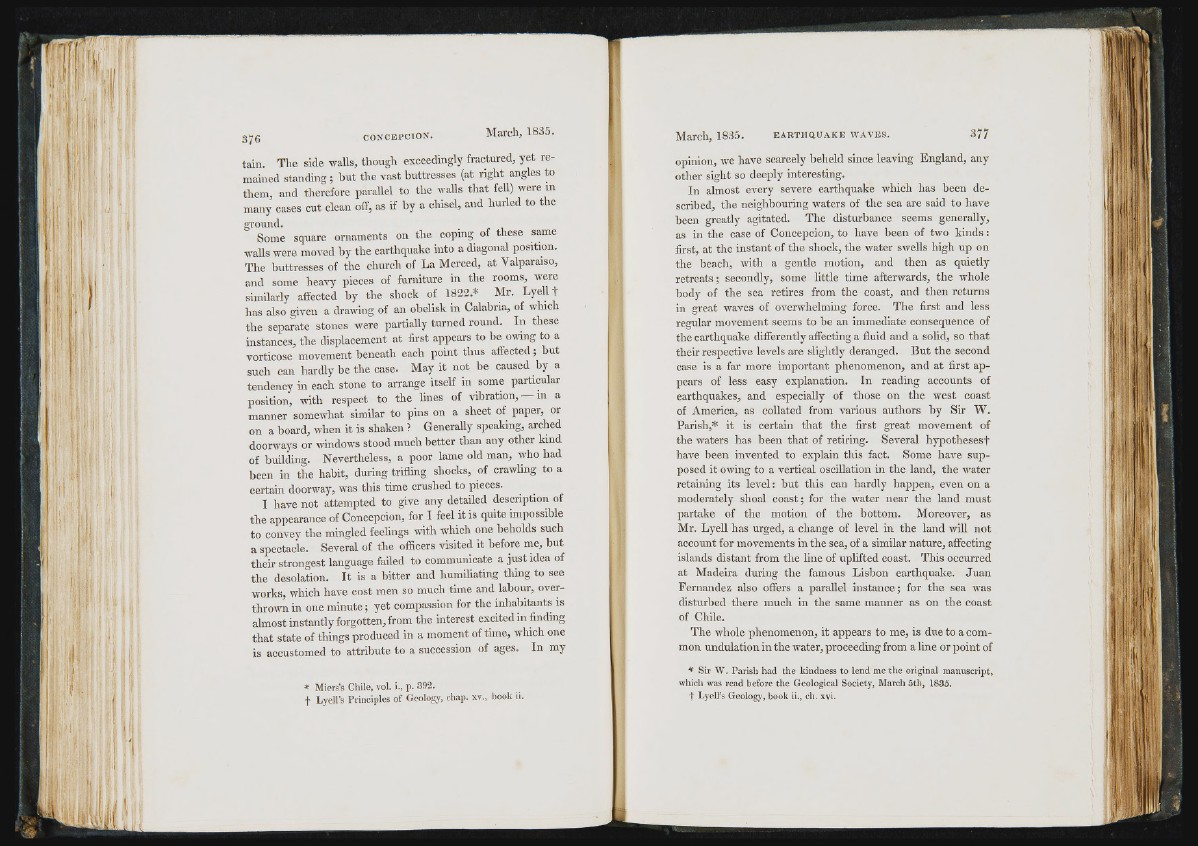
Hi I
ri'í
I'fjl
í ''I ,
■l í j f
tain. The side walls, though exceedingly fractured, yet remained
standing ; hut the vast buttresses (at right angles to
them, and therefore parallel to the walls that fell) were m
many cases cut clean off, as if by a chisel, and hurled to the
ground.
Some square ornaments on the coping of these same
walls were moved by the earthquake into a diagonal position.
The buttresses of the church of La Merced, at Valparaiso,
and some heavy pieces of furniture in the rooms, were
similarly affected by the shock of 1822.* Mr. Lyell t
has also given a drawing of an obelisk in Calabria, of wbicb
the separate stones were partially turned round. In these
instances, the displacement at first appears to be owing to a
vorticose movement beneath each point thus affected; but
such can hardly he the case. May it not be caused by a
tendency in each stone to arrange itself in some particular
position, with respect to the lines of vibration, — in a
manner somewhat similar to pins on a sheet of paper, or
on a board, when it is shaken ? Generally speaking, arched
doorways or windows stood much better than any other kind
of building. Nevertheless, a poor lame old man, who had
been in the habit, during trifling shocks, of crawling to a
certain doorway, was this time crushed to pieces.
I have not attempted to give any detailed description of
the appearance of Concepcion, for I feel it is quite impossible
to convey the mingled feelings with which one beholds such
a spectacle. Several of the officers visited it before me, but
their strongest language failed to communicate a just idea of
the desolation. It is a bitter and humiliating thing to see
works, which have cost men so much time and labour, overthrown
in one minute; yet compassion for the inhabitants is
almost instantly forgotten, from the interest excited in finding
that state of things produced in a moment of time, which one
is accustomed to attribute to a succession of ages. In my
* M ie rs ’s C h ile , vo l. i., p . 3 92.
t L y e ll's P r in c ip le s o f G e o lo g y , c h a p . xv., b o o k il.
opinion, we have scarcely beheld since leaving England, any
other sight so deeply interesting.
In almost every severe earthquake whioh has been described,
the neighbouring waters of the sea are said to have
been greatly agitated. The disturbance seems generally,
as in the case of Concepcion, to have been of two kin ds:
first, at the instant of the shock, the water swells high up on
the beach, with a gentle motion, and then as quietly
retreats; secondly, some little time afterwards, the whole
body of the sea retires from the coast, and then returns
in great waves of overwhelming force. The first and less
regular movement seems to be an immediate consequence of
the earthquake differently affecting a fluid and a solid, so that
their respective levels are slightly deranged. But the second
case is a far more important phenomenon, and at first appears
of less easy explanation. In reading accounts of
earthquakes, and especially of those on the west coast
of America, as collated from various authors hy Sir W.
Parish,* it is certain that the first great movement of
the waters has been that of retiring. Several hypotheses!
have been invented to explain this fact. Some have supposed
it owing to a vertical oscillation in the land, the water
retaining its lev e l: but this can hardly happen, even on a
moderately shoal coast; for the water near the land must
partake of the motion of the bottom. Moreover, as
Mr. Lyell has urged, a change of level in the land wiU not
account for movements in the sea, of a similar nature, affecting
islands distant from the line of uplifted coast. This occurred
at Madeira during the famous Lisbon earthquake. Juan
Fernandez also offers a parallel instance; for the sea was
disturbed there much in the same manner as on the coast
of Chile.
The whole phenomenon, it appears to me, is due to a common
undulation in the water, proceeding from a line or point of
* S ir W . P a r is h h a d th e k in d n e s s to le n d me th e o r ig in a l m a n u s c r ip t,
w h ic h was r e a d b e fo re th e G e o lo g ic a l S o c iety , M a rc h S th , 1833.
! L y e ll’s G e o lo g y , b o o k ii., ch . xvi.
iSi
if